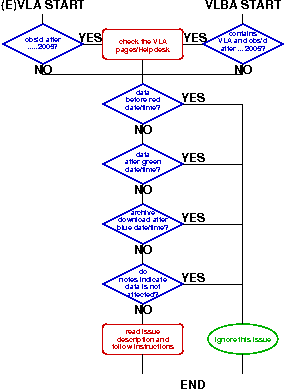For data taken between June 27 and August 21 antennas 11 and 19 had
an incorrect nominal sensitivity and system temperature stored with
the archival data. This can be identified by zeroes for the system
temperature in plots of Tsys in the TY table using SNPLT.
Unfortunately AIPS has not been calculating the weights for these
antennas correctly when loading the data using FILLM.
A patch dated September 28, 2007, is available for the 31DEC06
version of AIPS that handles this correctly.
For the 31DEC07 version of AIPS, a midnight job run on September 22,
2007, or later is needed.
You will need to update your version of AIPS and reload your data to
obtain the correct weights for the affected antennas. Any flagging
that has already been carried out is probably fine and FG tables can
be copied directly to the new dataset using TACOP.
Alternatively, if you already have fully calibrated data in a single
source file, you can run WTMOD on that file with:
NOISE=1; NOISE(11)=1/3; NOISE(19)=NOISE(11)
Projects that may have been affected:
AB1233, AB1239, AB1245, AB1246, AB1248, AB1250, AB1251, AB1254
AB1256, AB1257, AB1258, AB1278, AC843, AC856, AC874, AC879, AC881
AC884, AC888, AC908, AC909, AD562, AD565, AF452, AF456, AG744, AG745
AG752, AG753, AG756, AG757, AG777, AH939, AH941, AJ337, AK634, AK656
AL693, AL696, AL698, AL703, AM889, AM902, AM904, AM910, AN129, AO219
AO223, AR637, AR638, AR642, AR646, AS887, AS897, AS899, AS903, AS911
AS925, AT342, AT343, AT345, AU119, AW705, AY178, S8531
|
 Known problems are listed in reverse issue number, which over due time
will become a random order of (approximate) starting date, separated
for (E)VLA and VLBA issues (some may be listed under both if
applicable). However, as some issues may not be related to the data,
but to the data readers themselves, you may want to read the general
reader (FILLM or FITLD) issues first. If your data includes EVLA
antennas (as may be the case for data between 2005 and 2013), you
should also check the EVLA
returns page.
Known problems are listed in reverse issue number, which over due time
will become a random order of (approximate) starting date, separated
for (E)VLA and VLBA issues (some may be listed under both if
applicable). However, as some issues may not be related to the data,
but to the data readers themselves, you may want to read the general
reader (FILLM or FITLD) issues first. If your data includes EVLA
antennas (as may be the case for data between 2005 and 2013), you
should also check the EVLA
returns page.
